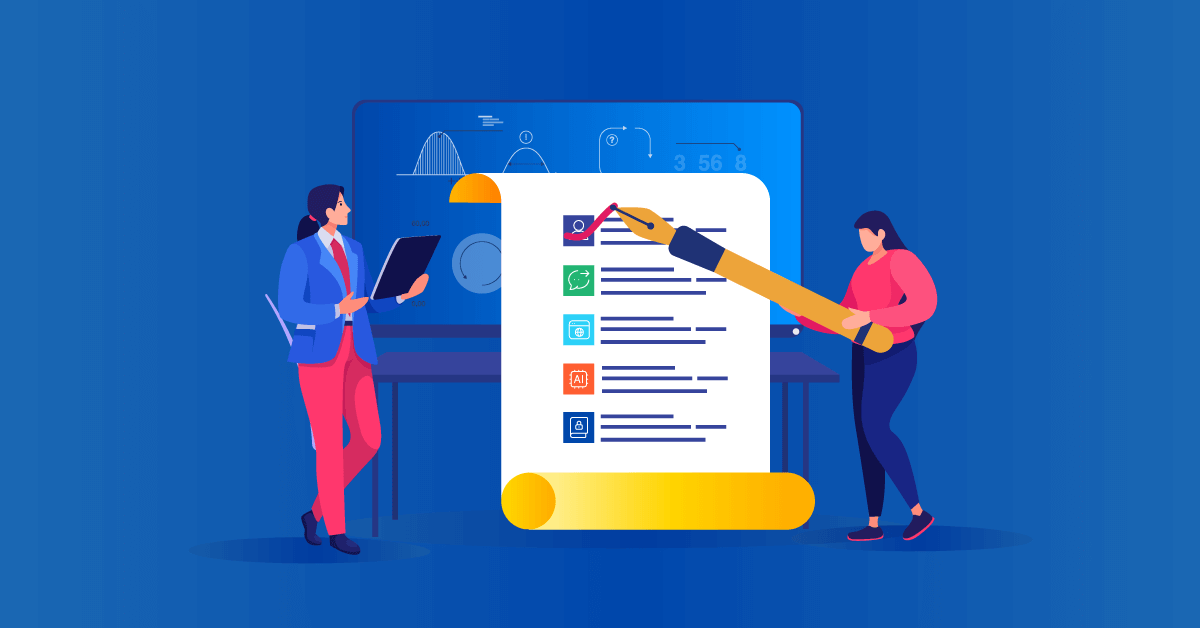Use it anytime. Take it anywhere. One of the big benefits of technology is its flexibility.
With a rich tech stack in place, you can do what you want, whenever suits you. This “self-paced” model is how most of us use technology in our personal lives. And it’s a model that’s also impacted the corporate world. Thanks to digital technology, most of us can work flexibly and remotely if we want to. And train flexibly and remotely, too.
Powered by technology, self-paced (asynchronous) training is when employees control their own learning journey. And it’s become a well-used method of training in most organizations. Particularly, those with mobile, remote, or globally-dispersed workforces.
But, while online learning is soaring, there are signs that suggest self-paced learning may be starting to struggle.
Worth $20.85 billion in 2016, the US self-paced online learning market dropped to $15.86 billion in 2021. $15.86 is still a huge figure. But it’s a big dip from previous years. And other stats underline this gradual downward trend.
With self-paced training starting to slump, could synchronous training (self-paced learning’s antithesis) be making a comeback?
In this post, we ask: “What is synchronous training?” and explore if it still has a place in the thriving world of eLearning. The stats suggest it does. But why? Let’s take a look.
What is synchronous training?
You’ll hear the terms synchronous and asynchronous used a lot in conjunction with employee training programs. We’ve briefly touched upon the meaning of asynchronous learning. But what is synchronous training? And how does it differ from the asynchronous self-paced model?
Well, the answer centers around its different approach to time.
When two or more people or things come together at the same time it’s usually described as being “in sync”. And this is how synchronous learning operates.
Unlike self-paced learning where employees work independently and set their own learning schedule, synchronous training happens for all participants in real-time. And, rather than learning on their own, learners who participate in synchronous training can interact with other learners and their instructors during the lesson.
Synchronous training is usually instructor-led, which often leads to the assumption that it takes place offline in a physical classroom. Not so. While synchronous learning has to take place at the same time for all participants, none of those participants have to be in the same place.
So, while classroom teaching is an obvious example of synchronous learning, it’s by no means the most common. Synchronous learning can take place online as synchronous eLearning.
There are a few examples where the two worlds meet. Blended participation, for example, where some students join an in-person, classroom-based session remotely using technology. But in most instances, synchronous learning happens either online or offline.
Let’s look at examples from both scenarios.
Offline synchronous training examples
- classroom lecture or presentation
- in-person role play
- physical demonstrations and assessments
- practical “how-to” sessions
- one-to-one in-person tutorial
- in-person coaching or mentoring session
- company or industry conferences in a physical venue (break-out groups would come under this too)
Online synchronous training examples
- audio conferencing
- live webcasting
- instant messaging
- videoconferencing or teleconferencing
- live-streamed lectures or demonstrations
- live-streamed webinars
- online chat rooms where learners arrange to meet at a specific time and date
Host webinars and ILT sessions with TalentLMS
The training platform that users consistently rank #1.
Easy to set up, easy to use, easy to customize.
The advantages of synchronous training
It may have been sidelined over the years, but synchronous learning’s still alive and well in the world of corporate and commercial eLearning. And there are the stats to prove it.
But what’s it got to offer that self-paced learning can’t provide? Quite a lot it seems.
- Build communities faster. When you have all of your learners together at the same time, they start to make connections and build a network. Immediately.
- Leverage peer learning. Real-time training sessions give participants the chance to learn from each other as well as an instructor.
- Boost teamwork and collaboration. Working together to achieve a task or explore an idea is easier when all members of a group are engaging at the same time.
- Increase social interaction. Synchronous training socializes learning. This makes it easier for ideas and opinions to be shared and discussed.
- Accelerate learning. Learners can get guidance or extra clarification directly and instantly from their course instructor. And this support, provided when needed, results in the faster absorption of knowledge.
- Improve engagement. Learning together “in the moment” leads to higher levels of involvement with the process and the learning purpose.
- Reduce isolation. Remote working is now the norm rather than the exception. But working off-site can lead to feelings of loneliness. Synchronous training sessions offer employees the chance to experience the “live” interactions they may be missing out on.
- Motivate learners. Learning alone can be demotivating because there’s no one else to provide encouragement or support, particularly during times of challenge or disinterest. Real-time training raises energy levels (e.g. through activities that involve the whole group) and the peer-to-peer reassurance needed to cope with dips in mood or morale.
- Improve completion rates. Self-paced learning requires students to take control and organize. Some learners find this tough and give up. Or, wait until it’s too late to get started. The structure of a synchronous learning environment takes that responsibility away from students, keeping them focused and on track. The real-time element also creates a sense of urgency which leads to greater participation.
- Get immediate feedback. How are your learners doing? Is the material achieving the right results? Using real-time tests, quizzes, and challenges, instructors can get immediate feedback. Misunderstandings are cleared up on the spot. And course content can be adapted to address any knowledge black spots.
- Enhance the learning experience. Synchronous learning is unpredictable—in a good way. Good because open and organic conversations, that happen in a live environment, generate new ideas and opinions. And these elevate learning by pushing learning goals onto another level.
- Strengthen stakeholder links. Synchronous learning has a confident and transparent quality to it which lends itself to customer or partner training. Engaging with stakeholders in a live environment personalizes the interaction. And this, in turn, strengthens relationships and builds trust.
The disadvantages of synchronous training
Synchronous training has lots going for it. But it’s not without its challenges. Here are some to consider when deciding on where it might fit within your eLearning program.
- Inflexibility: Your employees are busy people. Pinning your training down to a series of fixed dates risks alienating many who simply aren’t available. A live training session is unlikely to attract the same levels of attendance as a webinar recording delivered through your LMS.
- Time to reflect: Setting firm and fixed parameters for training (it’ll take place at X time, on Y date for Z hours) gives learners less time to step away, consider, reflect, and absorb information.
- Pace and scalability: If you’re a larger organization, growing at pace, you need to be able to ramp up training to meet growing demand. It’s harder to do this if you’re trying to gather large groups of employees together at the same time.
- Exclusion: Delivering to larger groups at the same time, might leave some learners feeling left out. [Tip: Introduce one-to-one or group Q&A break-out sessions within your live training.]
- Mobility: Employees who work out of the office often use phones to access training. It’s not so easy to engage in a live online training event using a mobile device.
- Accessibility: Ensuring 100% accessibility is more difficult with real-time training. Whether it’s a physical event or a live online session, there are more factors to consider and plan for. And more that could go wrong on the day.
- Quality control: Most real-time learning is instructor-led. Which means the quality of each training event depends on each individual instructor or leader.
- Expenses: Depending on the nature of your synchronous learning (large, in-person conference-style event or live video conference), costs could be a lot higher than other asynchronous approaches.
- Geography: Real-time training is virtually impossible if you’ve got a globally dispersed workforce who cross time zones and speak different languages.
- Individuality: People learn in different ways and at different speeds. Synchronous training limits choice and can prevent certain groups or individuals from benefiting in the same way.
- Focus: Learning in a live environment can be draining as there’s often little chance to take time out and re-energize. [Tip: Factor in interactivity, keep sessions short, and regularly recap and review.]
- Technology: Live streaming video, and connecting to online meetings, places demands on data and requires fast internet connections. If your learners don’t have the technical infrastructure in place, they could experience glitches.
- Troubleshooting: Whether it’s a webcam or a mic that stops working or files that disappear, audio and video troubleshooting can overshadow synchronous training sessions.
- Experience: Synchronous training takes forethought and planning. And, even then, there are events or incidents you can’t prepare for. Which means it’s hard to guarantee a consistent experience for all employees at every session.
Blended learning: The best of both worlds
So, synchronous vs. asynchronous learning. Which to use? Well, with the right tools, technology, and resources in place, the best approach is to pick and choose elements from both.
That way you can target different types of learners in different ways. And adapt your approach to suit the individual nature of your specific training program. And the type of organization and workforce you’re managing.
Synchronous learning, for example, can be a more effective way of updating employees on changes to company policies. Or, introducing them to a new piece of software. It also lends itself to training the practical skills linked to sales or customer service. Or, the physical skills needed in certain trades.
But it might not be viable if you’re an international company, scaling up and onboarding thousands of employees worldwide over a short period of time. Or, if you want your employees to understand the theories behind a certain management or leadership approach, for example.
The good news is, if you’re using a Learning Management System (LMS) for your training, providing a blended learning approach is easy. Use pre-packaged web and mobile-based online learning for the bulk of your courses, and combine this with real-time classroom or webinar-based training sessions.
And remember, synchronous learning isn’t outmoded or dated. With a rich tech stack in place (instant messaging and discussion tools, interactive web-casting, and video conferencing) you can create a dynamic, interactive, and engaging “live” experience for all of your learners, befitting of a modern workplace.
Making a comeback? Synchronous learning never left. It just got better.




